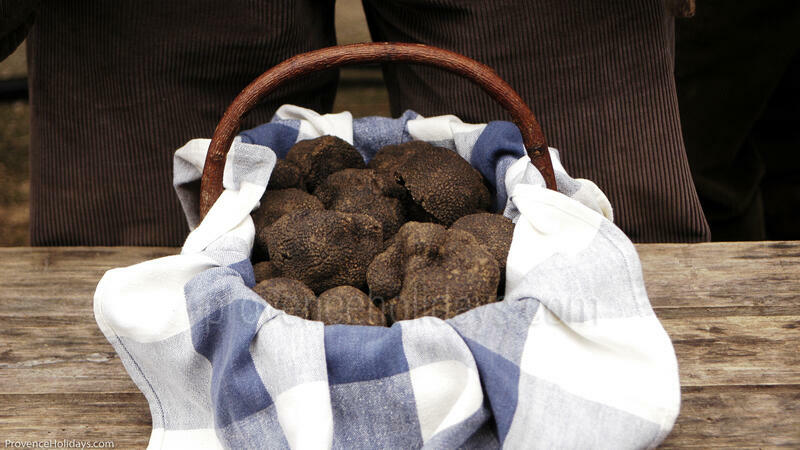Truffles
History
It is difficult to know when this mysterious black fungus appeared on Earth. Some claim that it was discovered in ancient Egypt (2600 BC), others locate it in ancient Rome or Greece. Philosophers such as Plutarch and Theophrastus refer to it as a fungus caused by stormy rain and lightning. For centuries, the truffle was banned from all tables.
It was Francis I (1494-1547) who first introduced it to court. From that time onwards, truffles were highly prized and became a luxury product at the end of the 17th century under Louis XIV.
Until the 18th century, it remained a mysterious mushroom and was the subject of the wildest rumours. A legend tells that at night, witches gather at the foot of oak trees to dance and that, in the early morning, they leave a trace of dead grass on the ground which is called a 'witch's circle'. And truffle growers know that this is where truffles are found.
But for the great chefs, the truffle is an exceptional mushroom. The famous gastronome Jean Anthelme Brillat-Savarin (1765-1826) did not hesitate to say that the truffle is "the black diamond of gastronomy".
We owe the cultivation of truffles to Joseph Talon. In 1808, this native of Saint-Saturnin-les Apt had the idea of planting oak acorns, only to discover ten years later a few kilos of 'rabasses' (name given to truffles in Provence). He then understood the symbiosis between the oak and the mushroom. He decided to sell plants from his land and to develop truffle growing at the foot of Mont Ventoux and throughout the Vaucluse, and made a fortune. The Vaucluse remains the leader in truffle production. The "rabasso negro" is grown there.
Varieties and Flavours
The truffle is a mushroom that lives underground and is 75% water. It is found in the shade of the green and white oaks of Provence.
In Provence, there are three main varieties:
- Black Truffle: known as the "black diamond", the black truffle is the most sought-after and most expensive, with firm flesh streaked with fine white veins, and a delicately musky flavour that evokes the undergrowth in autumn. It is harvested from November to March. It is found in the Vaucluse, the south of the Drôme and in the south-east of France (Gard, Bouches-du-Rhône, Alpes-de-Haute-Provence and Var).
- Tuber Brumale: very similar to the black truffle in appearance and flavour, it is harvested between December and March. The tuber brumale is found in the same areas as the black truffle.
- White Summer Truffle: or St. John's truffle, is only eaten raw or grated due to its subtler taste. It is harvested between May and September. For a long time disdained, it is now enjoying a revival of interest.
The Question on Everyone's Mind
Can we plant truffles?
Well, no! Truffles cannot be sown or planted!
They are born spontaneously when spores or mycelium, a substance that stretches 20cm below the surface of the soil, meet the rootlets of an oak or other tree species with which they can develop. At these junctions, the mycorrhizae are formed and the truffles are born. They then draw their nutrients from the tree to which they are attached, although there do not seem to be any physical connections.
How to Eat Them
The black truffle can be eaten raw, in thin slices, or cooked. It goes well with all kinds of dishes, egg-based recipes, vegetable soups or pasta, ravioli, risotto, with meat, fish and shellfish. It can also be used in a cream sauce or beurre blanc.
The white truffle can only be eaten raw, and can be served with pasta, fried scallops or a velouté.
A Recipe
Truffle Brouillade/Scrambled Eggs:
|
Preparation time: 15 mins Cooking time: 20 mins Resting time: at least 2 hours Difficulty: easy Cost: €€€ |
Ingredients per person: 2 eggs + 1 egg for the pan |
- Two hours before: beat the eggs with the truffle, olive oil, salt and pepper.
- Cover the bowl with a cloth and leave at room temperature.
- Just before serving: pour the mixture into an oiled frying pan and heat over a low heat, turning the mixture constantly in the pan.
- Remove from the heat as soon as the consistency is creamy.
- Serve on a slice of toasted country bread.
- Enjoy!
Where to Buy Them
Truffle production extends over 15 communes in the Vaucluse and 68 communes in the Drôme provençale. You will find them on many markets!
To find out more, visit the website: www.provence7.com/bonnes-adresses/villes-et-villages-truffes-en-provence
Truffle Events
Most events take place at the beginning of the year. For more information, please visit: www.provence7.com/bonnes-adresses/villes-et-villages-truffes-en-provence

